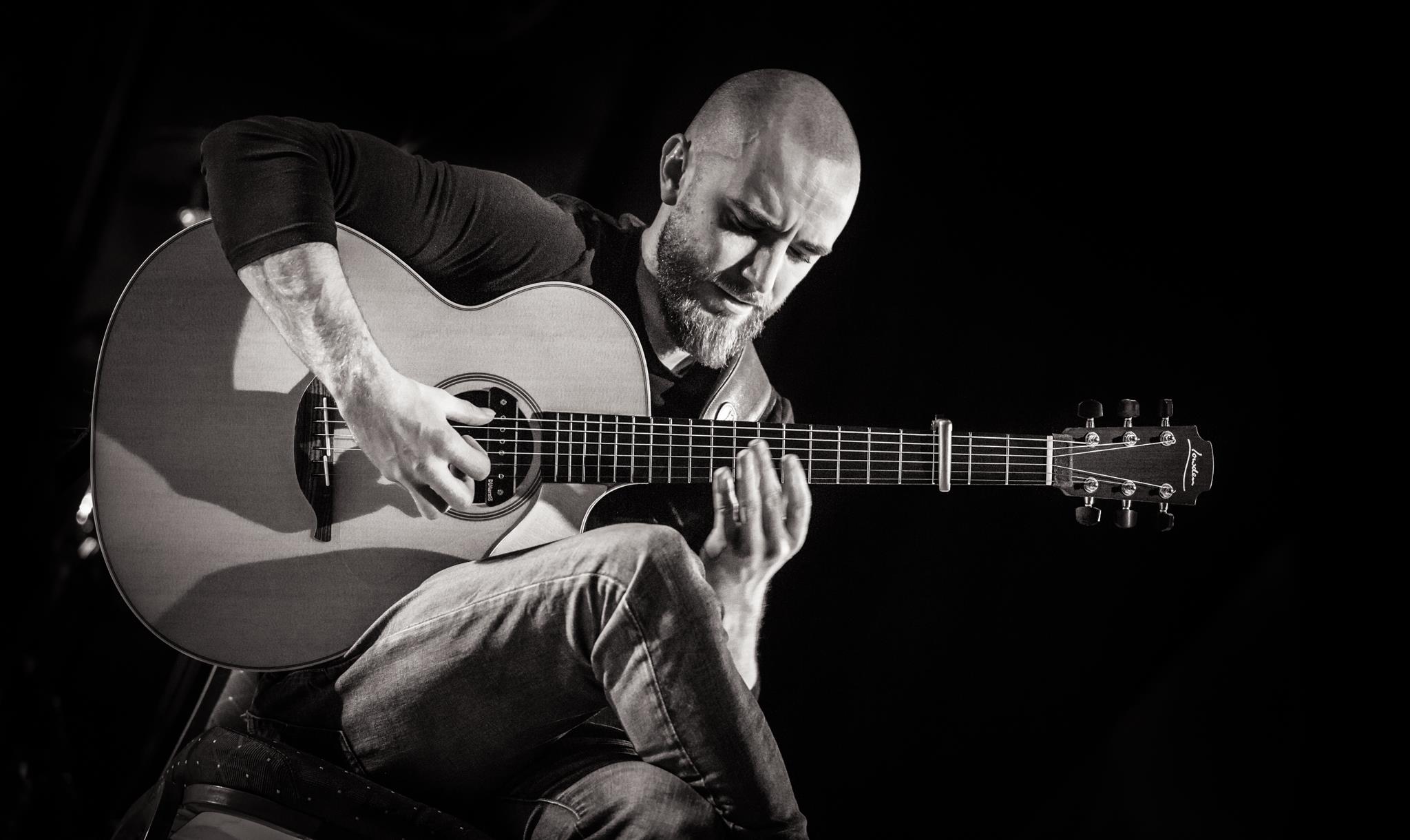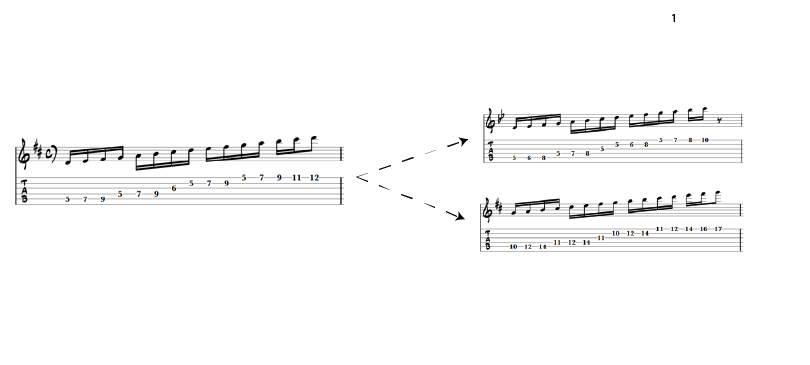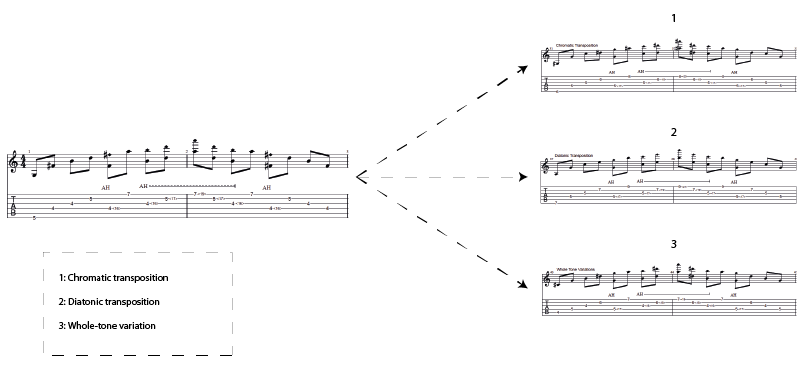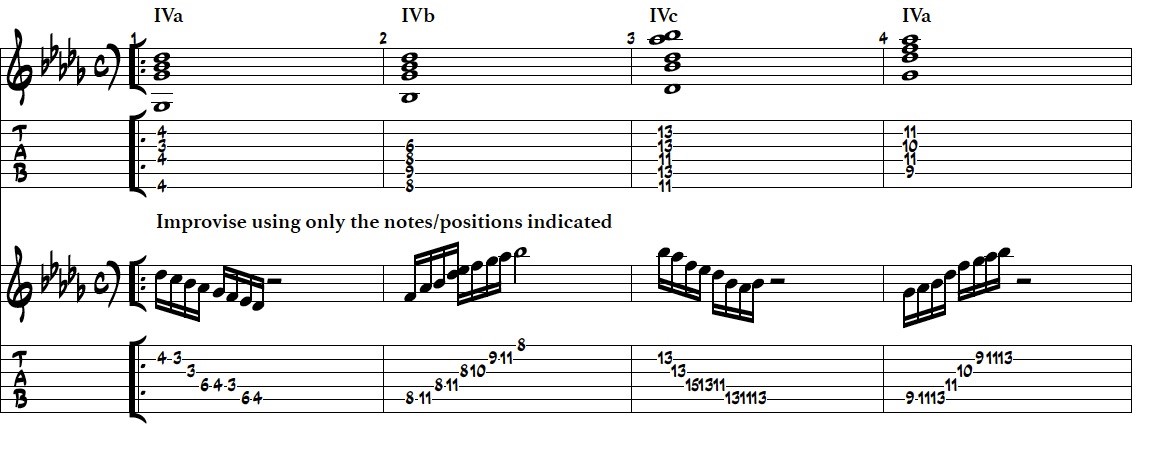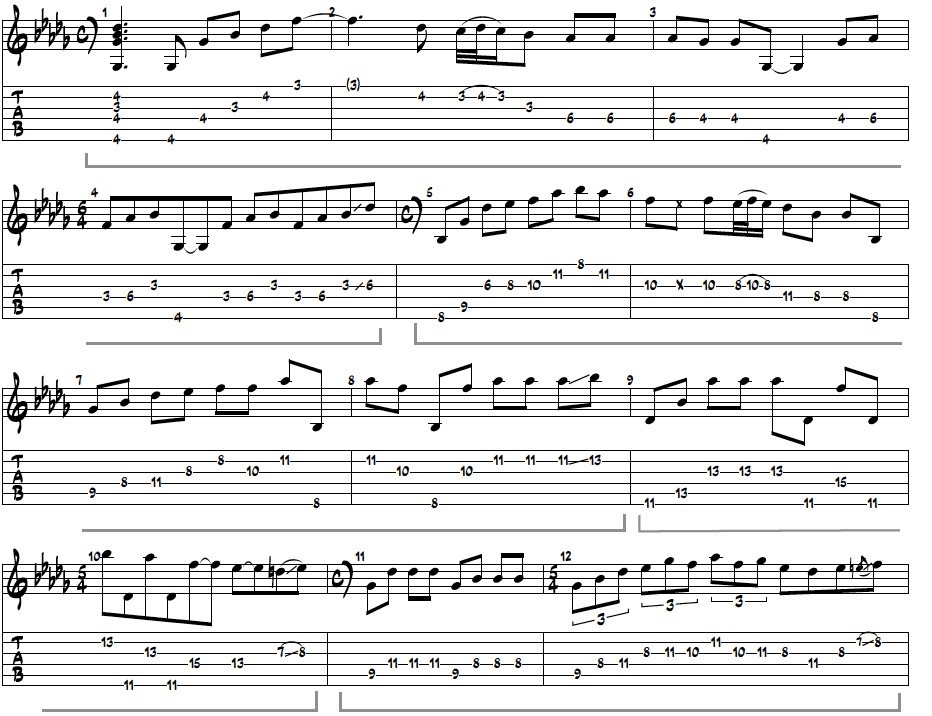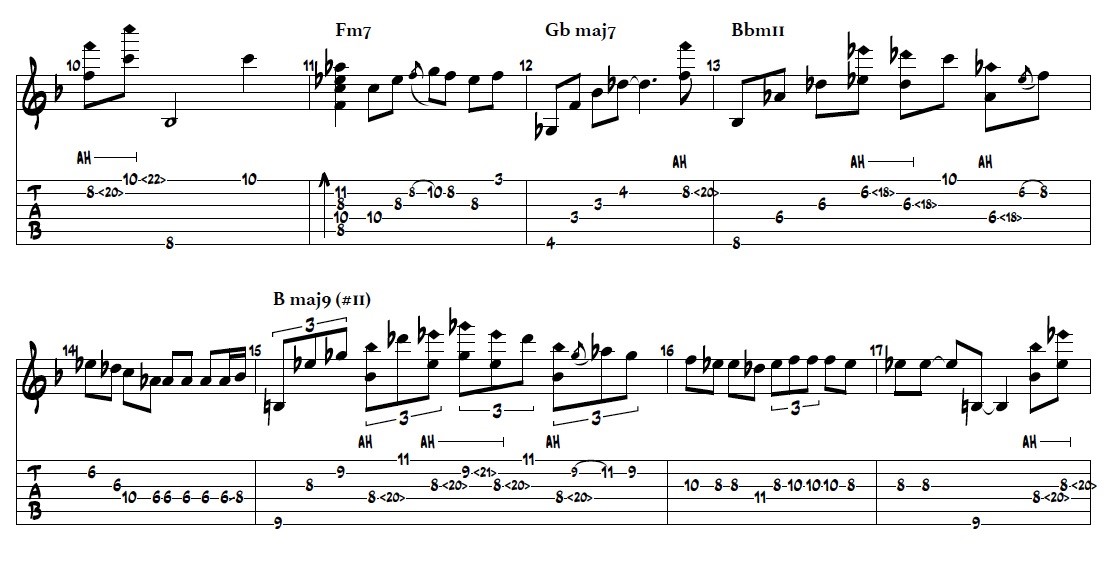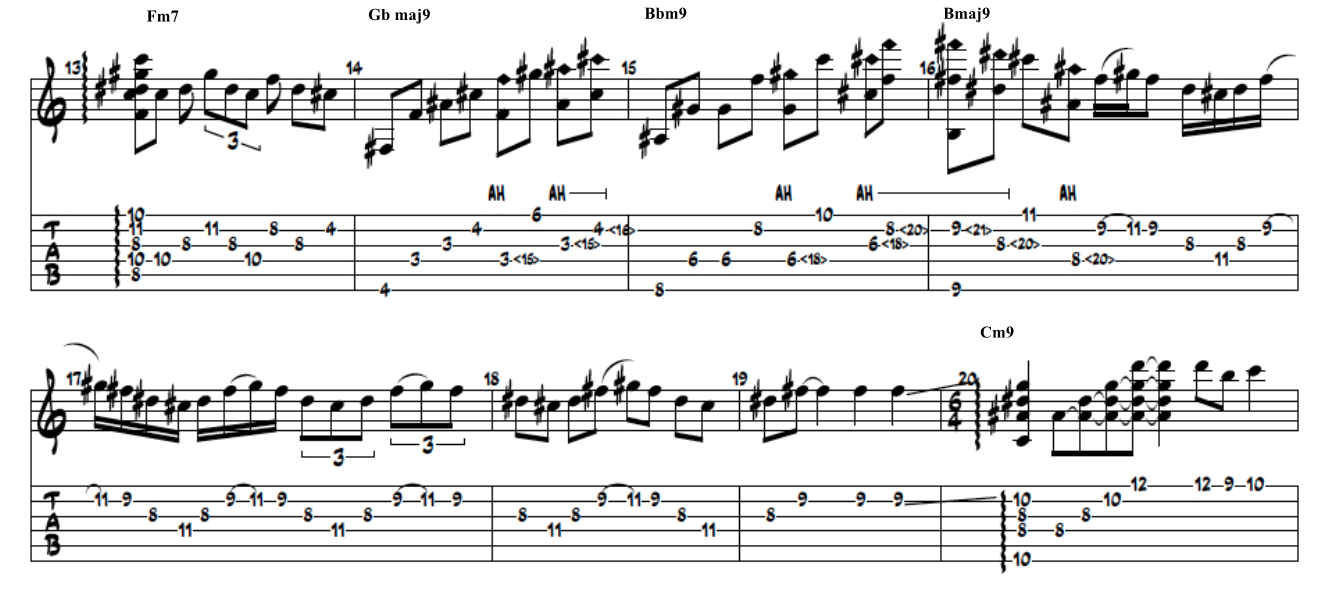A Cognitive Approach to Contemporary Fingerstyle Guitar Improvisation
DOI: 10.32063/0902
Table of Contents
- Introduction
- Formulas: The building blocks of an improviser’s vocabulary
- Schemata: Formulas and their Variations
- Etudes and models: Developing procedural memory
- Developing improvisational fluency
- Methods
- The modular vocabulary component
- Transposition and variation
- Learning Recombination Principles
- The Model Improvisation
- Commentary
- Conclusion
- Appendix – Transcription Portfolio
Gary Lutton
Gary Lutton is a musician, researcher and educator from Belfast, Northern Ireland. He is the winner of Sky Arts’ ‘Guitar Star’ (2015) and has toured as a solo artist in Europe, USA and China as well as playing for the Nitin Sawhney Band. In 2020 he was awarded a PhD from Ulster University for his thesis, Contemporary Steel-String Fingerstyle Guitar: Developing New Vocabulary and Improvisational Approaches. Gary is also a lecturer in music and coordinator of the Belfast Guitar Night.
by Gary Lutton
Music & Practice, Volume 9
Scientific
Introduction
This article explores a particular development in my creative practice as a contemporary fingerstyle guitarist: the ability to improvise in a style that is generally not improvisatory. Contemporary fingerstyle guitar is a modern approach to fingerstyle guitar which makes use of extended techniques, altered tuning systems and polyphonic arrangements. I have been a practitioner of this style for over 10 years, having drawn influence from artists like Michael Hedges and Thomas Leeb while establishing my own musical voice. However, I have often felt restricted in terms of my abilities to be spontaneous and improvise due to the polyphonic nature of the style coupled with ever-changing altered tuning systems. This article aims to address this by exploring the question: How can I introduce improvisation into my creative practice in a way that embraces the personal stylistic traits I have been developing over the past 10 years?
There are a vast number of pedagogical texts available on improvisation. However, most of them have limited utility for my purposes as they deal with a particular musical language – generally jazz, and often specifically bebop.[1] The bebop approach, for example, tends to focus on developing linear improvisations over a pre-composed harmonic context (the ‘changes’). This has obvious limitations for the solo improviser who doesn’t necessarily have these constraints to work with. While I find engaging with these jazz-based approaches to be both rewarding and challenging, it is clear that another approach is needed if I am to incorporate the contemporary fingerstyle guitar vocabulary into my improvisations. The question then becomes: How can I use my existing technical and stylistic repertoire as the basis for improvisations? And how can it be deconstructed, developed and reassembled in a way that enables improvisation?
The solution, it seems, begins with asking a more fundamental question: How does any musician improvise regardless of idiom? What are the meta-processes of musical improvisation? And can an understanding of this be used to create an improvisation method? These questions all point towards understanding the cognitive processes of improvisation as the foundation for my investigation. By ‘cognitive processes of improvisation’ I refer to the cognitive systems associated with learning to improvise including things like developing ‘specialist memory’ and ‘schemata’ (these terms will be explored later). The aim is not just to understand these processes but to use them as the basis for developing improvisation skills. In theory, by taking such an approach, any musical material could be used as the building blocks for improvisations. Therefore, I could reconstruct my existing vocabulary (my personal repertoire of stylistic traits, devices and techniques) in a way that is improvisatory.
Formulas: The building blocks of an improviser’s vocabulary
A prominent theory of improvisational behaviour is that it is pattern-based – a stringing together of pre-learned musical events. Martin Norgaard,[2] for example, demonstrated that the majority of Charlie Parker’s vocabulary consisted of patterns that were reused throughout his solos. But what do these patterns actually consist of? In Parker’s case they often consist of musical phrases or ‘licks’ for use over common 2–5–1 jazz chord progressions. However, for Classical-era keyboard improvisers these patterns may consist of fundamental harmonic progressions and various ways to realize them (e.g. by arpeggiating chords).[3] Patterns are the modular building blocks of the improviser’s vocabulary–what Berkowitz terms ‘formulas’ and defines as ‘musical materials equally useful for possible insertion into an improvisation and for transmission of fundamental aspects of the musical language in a distilled or simplified fashion’.[4]
From a cognitive perspective, these formulas are manifestations of what Jeff Pressing[5] terms specialist memory and the knowledge base. Specialist memory refers to domain-specific memory in which experts retain vast quantities of information using various techniques which encode meaning into groups of seemingly random information units. One example of this is what is known as ‘chunking’. A study by William Chase and Herbert Simon found that chess masters recalled chess positions with vastly greater accuracy and speed than novices did, but only when the positions corresponded to plausible playing positions.[6] In other words, instead of memorizing the position of each individual piece, chess masters were able to condense the positions of many pieces into a single unit – a ‘chunk’ – stored in their long-term memory. If specialist memory is stored chunks of information, then the knowledge base is the development of these chunks into usable techniques and the application of these techniques to various contexts. In musical terms, specialist memory may represent a conceptual knowledge of harmony while the knowledge base may represent the ability to perform and move between various harmonic progressions.
Schemata: Formulas and their Variations
Formulas must be transposable, adaptable and in some sense modular – that is, they must be able to be combined in different ways. A formula that is context-dependent is almost by definition non-improvisatory. Great improvisers seem to be able to take an idea (i.e. a ‘formula’) through almost any musical context seemingly unfazed by changing key-centres or even musical styles.[7] The essence of the musical idea remains intact while certain elements are fluid and adaptable. This same concept is articulated from a cognitive perspective in Richard A. Schmidt’s seminal work, A Schema Theory for Discrete Motor Skill Learning.[8] Schmidt suggests that motor skill learning can be explained in terms of a cognitive schema[9] in which the structure of a given class of movement is stored as a generalized motor program (GMP). Execution of a motor task engages this GMP and applies parameters relevant to the current situation. Schmidt exemplifies this in terms of throwing a ball:
a motor program for throwing a ball could be modified by specific instructions to throw fast or slow. These specifications can be thought of as parameters that can be varied before the movement begins to enable the execution of the program at a different speed, a different force, and so on. Thus the performer’s problem in choosing a movement is the determination of the response specifications that will modify the existing stored motor programs.[10]
Schemata develop when multiple variations of the same movement type are practised, thus allowing for the abstraction of commonalities. The strength of the schema is directly correlated to the amount of specific movement variations executed and the precision and proximal timing of feedback. Charles Shea and Gabriele Wulf[11] suggest that a GMP should be instantiated first with parameterization integrated later. Simultaneous practise – of structure and parametrical variation – results in disrupted GMP learning.[12] For the improviser, schemata are represented by formulas and parameterization is represented by their variation and transposition. Therefore, a formula should be concretely established in the first instance and only then should it undergo various forms of transposition (e.g. diatonic, chromatic, modal) and variation (e.g. rhythmic, intervallic, timbral). In theory, the more variations created and practised on a given formula, the stronger the cognitive schema for that formula becomes.
Etudes and models: Developing procedural memory
Both working memory and long-term memory are involved in the process of improvising. Working memory is engaged in real-time conscious decisions, error-correction and problem-solving while long-term memory reflects the stores of pre-programmed devices – specialist knowledge and the knowledge base. It is the improviser’s seemingly remarkable long-term systems that are of interest in this article.
The long-term system is divided into two categories: declarative memory and procedural memory. Declarative memory is associated with increased brain activation involving ‘conscious recollection of previous experiences’.[13] Procedural memory refers to the learning of motor and cognitive skills,[14] as well as the notion of muscle memory.[15] Learning to improvise is a skill that, as Berkowitz notes, involves both declarative and procedural processes.[16] However, it is clear that procedural memory plays the dominant role during improvising: to the improviser the act of improvisation tends to feel like an unconscious process rather than a conscious recollection of licks and phrases.
So how does an improviser actually develop procedural memory? How do we practise improvisation? For this, two strategies or ‘improvisational exercises’ are particularly noteworthy. The first is the conception and practise of improvisatory etudes. The main difference between an improvisatory etude and a traditional etude is its function: the improvisatory etude aims to instantiate what Berkowitz terms ‘recombination principles’ rather than a given technique. For Classical-era keyboard improvisers these principles were often presented in various forms from short progressions, to arpeggiated flourishes, to preludes of up to 20 bars in length.[17] Importantly, each prelude is composed of ‘modular components which can be mixed and matched’ reinforcing ‘interconnections between the different motives’.[18] In other words, improvisatory etudes are composed of formulas and their function is to develop the procedural memory required to fluidly combine multiple formulas.
The second exercise is the practising of model improvisations. These are exemplars of typical improvisations or allied compositions initially learned note-for-note. Models help transfer implicit knowledge in a way that cannot be transferred through prose.[19] Berkowitz suggests that before learning to improvise, one must be familiar with a large corpus of compositions in the style in which they wish to improvise, as the ‘devices used for development of ideas or seeds … are in general very similar to those of the allied compositional practices’.[20] Model improvisations provide explicit examples of formulas and their concatenations as well as transferring implicit elements of style and combinatorial principles.
Finally, both etudes and models can function as a referent which is defined by Pressing as ‘a set of cognitive, perceptual, or emotional structures (constraints) that guide and aid in the production of musical materials [during an improvisation]’.[21] The referent enables the improviser in a number of ways, most significantly by freeing up cognitive processing power, which allows a performer to attend to higher-order processes such as emotional engagement. According to Pressing, the more intimately familiar one is with the referent the more processing power is freed up.
Developing improvisational fluency
One of the most striking aspects of an improvised performance is the apparent automaticity with which a performer executes their music. This phenomenon is explained in Anderson’s ‘Adaptive Control of Thought’ (ACT) theory by what is termed knowledge compilation. This involves a ‘progressive shift from the use of declarative knowledge to that of procedural knowledge, and an increase in automaticity’.[22] Knowledge compilation is a two-part process involving proceduralization and composition. Proceduralization requires the ‘creation of specific production rules’ which ‘reduce or eliminate the necessity to search through long-term memory during skilled performance’. Composition involves ‘reducing a repeated sequence of actions to a more efficient single sequence’.[23] Knowledge compilation is a critical component in improvisational skill acquisition, as Pressing highlights: ‘Part of the effect of improvisational practice is to make motorically transparent by overlearning what has been conceptually mastered.’[24] In other words, the material that arises during improvisation isn’t spontaneous in the sense that it is ‘unpractised’. On the contrary: the material is available to the performer in a spontaneous manner precisely because it has been practised to the point of automaticity; it has been made ‘motorically transparent’.
Furthermore, great improvisers seem to have a deep understanding of their musical materials from various perspectives. In cognitive terms, they have built up extensive ‘redundancy’ or ‘synoptic links’ between various aspects of the musical material, for example, between the acoustic properties, musical properties and movement properties. Pressing notes: ‘The distinguished expert has materials that are known in intimate detail, and from differing perspectives, and the various materials or modules are cross-linked by connections at various levels of the hierarchical knowledge structure.’[25] Thus, a significant difference between the novice and expert is the degree of redundancy or ‘connections at various levels of the hierarchical knowledge structure’. It seems that access to relevant knowledge via multiple pathways is a key component in expertise. From this perspective the development of improvisational skill consists not only in assembling a library of formulas and strategies for deployment, but also in the build-up of cognitive redundancy by forming strong synoptic links between elements of the knowledge base. This explains the reasons for my difficultly in improvising within the contemporary fingerstyle guitar idiom: the ever-changing tuning systems inhibit the formation of these synoptic links between the musical and movement aspects (e.g. a C major chord in BEDF#AD tuning looks very different in CGDGBD tuning).
Methods
The following methodology is based on the literature explored above. It articulates a systematic approach to developing my contemporary fingerstyle guitar practice in an improvisatory way. It is composed of four elements or ‘steps’:
- The conception and learning of modular vocabulary components (MVCs);
- the transposition and variation of MVCs;
- learning recombination principles through improvisatory etudes;
- practising model improvisations.
This approach is flexible in that it can facilitate many musical styles. However, that is not to say that the outcomes will necessarily be free from a given musical context. The following, for example, uses elements of my own existing vocabulary including jazz-influenced harmonic concepts, contemporary fingerstyle guitar techniques as well as subtle elements of Irish traditional music and Indian classical musics. One notable technique worth mentioning is my frequent use of harmonics, specifically, what are often termed harp harmonics or the harp harmonic technique. This refers to a technique in which cascades of harmonics are combined with open/stopped strings to create a harp-like effect. This allows for the execution of arpeggiated flourishes without much (if any) left-hand movement.
The modular vocabulary component
The modular vocabulary component (MVC) refers to a small fragment of vocabulary that is adaptable to various contexts and variable across a potentially unlimited number of dimensions. It is modular in the sense that it is an independent unit that can be applied to various systems (in this case, a given musical context) by concatenating strings of MVCs. MVCs are analogous to Berkowitz’s formulas. The first step in this method involves the conception and learning of MVCs. The idea is to first expand specialist memory by learning theoretical concepts. This could include learning scales, arpeggios, chords and fundamental harmonic progressions. This theoretical knowledge is then converted into a series of short useable musical devices – modular vocabulary components – establishing a knowledge base. Finally, as practise ensues, the process of knowledge compilation occurs in which knowledge shifts from declarative to procedural, becoming less conscious and more automatic.
Figures 1-3 demonstrate this process using a simple D major scale figure in DADGAD tuning. A single tuning was chosen for all of the material presented in this exposition to allow a build-up of associations between the cognitive processing structures. Altering the tuning of the guitar changes the position of scales, chords and arpeggios and therefore the player has less opportunity to build up associations. Using a single tuning allows one to conceive of, and link, each musical event in terms of its acoustic properties, musical properties and movement properties. DADGAD is particularly advantageous in that it is neutral sounding, and contains only three notes: D, A, G.
Transposition and variation
This step involves transposition and variation of the established MVCs. Transposing each MVC serves the obvious function of making them available in various harmonic contexts. Variation functions both to develop new vocabulary and to instantiate improvisatory principles. It generates new vocabulary by altering some aspect across any number of musical dimensions (e.g. timbral, intervallic, or rhythmic), which can, in turn, be altered again. Thus, any MVC has potentially infinite possibilities for development and, as a result, only a limited vocabulary is necessary for limitless possibilities. Further, variation instantiates improvisatory principles by developing a schema; rather than storing every single motor pattern for every single variation, a generalized motor program (GMP) is stored for a given class of movement. The more movement variations that are practised the stronger the abstracted schema becomes. In other words, practising many variations of a given figure fortifies the general framework of it. Its essence becomes more deeply engrained.
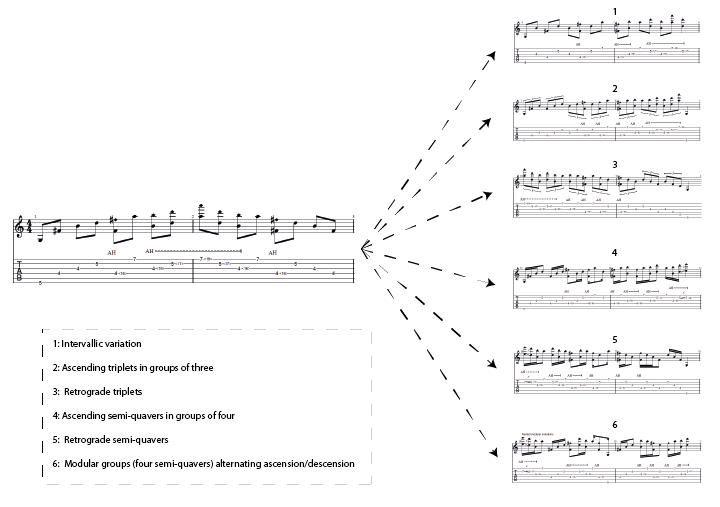
Figure 6 Gmaj9 arpeggio: further variations (individual transcriptions of variations can be found in the appendix).
Learning Recombination Principles
This step involves learning grammatical rules for the concatenation of MVCs into longer sections. This is both an explicit and implicit process which is best instantiated through the conception and practise of improvisatory etudes. Improvisatory etudes force one to impose certain musical processes or rules onto pre-existing MVCs and their variations (for example, the rules of diatonic harmony). Practising the etudes allows one to develop the procedural memory to internalize these rules and build up cognitive redundancy by forming links between the discrete elements of one’s knowledge base.[26] An excerpt from ‘etude 2’ is displayed below. This demonstrates the application of an MVC (in this case, one based on the harp harmonic technique) to various harmonic processes (i.e. diatonic/chromatic progressions).
The Model Improvisation
This step involves learning exemplars of typical improvisations or allied compositions, initially note-for-note. Models help transfer implicit knowledge in a way that cannot be explicitly communicated. They help inspire MVCs as well as internalize recombination principles, thus they can be used both as a practical tool and as a source of inspiration and creativity.
John McLaughlin’s piece A Lotus on Irish Streams was selected as a model improvisation due to the rich harmonic vocabulary, the free-time feel and the pianistic flourishes which lend themselves to the harp harmonic technique. The original was written for guitar, piano and violin but has been arranged for solo guitar. An excerpt from the transcription is presented, demonstrating the harmonic and melodic realization of the piece in DADGAD tuning.
Commentary
The following section presents two solo guitar improvisations. They can be viewed as the creative outcome of my improvisation ‘training’ in the methods section. Both were recorded with a Zoom H4n recorder after around three months of work spent devising and practising the etudes and the model. Full transcriptions are provided in an appendix. Other improvisations were recorded and transcribed; but these two were selected as they highlight the link between the previous section – in particular the etudes and model – and my creative practice as an improviser. The audio presented here is the primary articulation of the research outcomes, while the following commentary provides some context and highlights certain key aspects for each improvisation.
Improvisation 1
Improvisation 1 is based on an improvisatory etude[27] devised to instantiate recombination principles. The purpose of the etude is the familiarization of chord shapes, inversions and corresponding scalar patterns in DADGAD. It was deliberately formulated in an awkward key (D-flat major) so that familiarization with diatonic harmony in that key would be easily transferrable into more accessible keys (C, D, G etc.). The referent here is a chord progression with each chord undergoing systematic inversions.
| Chord | Positions played | Bar | Diatonic Function |
| Gb | Root, 1st and 2nd inversion, root (octave) | 1–4 | IV |
| Db | Root, 1st and 2nd inversion, root (octave) | 5–8 | I |
| Bbm | Root, 1st and 2nd inversion, root (octave) | 9–12 | vi |
| Ebm | Root, 1st and 2nd inversion | 13–16 | ii |
| Ab | Root, 1st and 2nd inversion, root (octave) | 17–20 | V |
| Db | Root, 1st and 2nd inversion, root (octave) | 21–24 | I |
Figure 9 Harmonic Overview of Etude 4.
The transcription has two staves: one for the chord position, and the other for the corresponding scalar position. The idea was to have the scale easily accessible while maintaining the chord. Each chord was given four bars, each representing an inversion: (1) root, (2) first inversion, (3) second inversion, (4) root, usually one octave higher. Therefore, with enough practise and enough knowledge compilation, the aim was that this etude would facilitate access to chords and corresponding scales across the fretboard, as well as develop fluid connections between positions.
The improvised realization of the etude is much more elastic in terms of rhythm. For example bars 1 and 2 of the etude are allotted four bars each in the improvisation, while bars 3 and 4 are allotted two bars each. The degree of elasticity depended on real-time creative choices.
Improvisation 2
This improvisation is based on an improvisational model devised in the methods section. The purpose of the model was the implicit transfer of harmonic vocabulary and approaches to harmonic realization. It imposes harmonic language that is fairly awkward to execute in DADGAD, serving to expand the harmonic knowledge base.
Below are two examples of the harmonic structure being realized in various ways. The first is from the improvisational model and the second is an improvisation on the harmonic structure of the arrangement. Although the former contains a degree of improvisation, the latter is fully improvised with the exception of the harmonic structure acting as the referent. Notably, both examples make extensive use of the harp harmonic technique. This allows for wide pitch ranges to be executed with little left-hand movement. In other words, the guitar can imitate some of the material originally played on piano (with scalar flourishes, arpeggios etc.).
Conclusion
My fundamental aim for this investigation was to develop a way to improvise within the contemporary fingerstyle guitar idiom. The idea was to take my existing (non-improvisatory) musical vocabulary and develop, re-organize and assimilate it back into my practice in a way that facilitated improvisation. The theoretical foundation for this approach was largely based on the cognitive processes of improvisation, investigating how an understanding of these processes can have a practical application, namely, in the development of an improvisation method that isn’t attached to a particular musical language.
The aim of the methods section was to develop a protocol for improvisational development that was based on cognitive procedures and their implications. This is in contrast to other methods – for example, those often used in jazz pedagogy – which largely involve musical rather than cognitive procedures. This is not to diminish the value or efficacy of other methods but simply to present a cognitive approach which may be of use to some practitioners, especially as an adjunct to their current practice.
The solo guitar improvisations reflect my personal vocabulary developed over many years presented in an improvisatory context. Previously, a lot of my repertoire had been developed in a fairly rigid manner and improvisation didn’t seem possible without transitioning directly into some form of jazz. However, exploring these cognitive approaches has allowed me to introduce improvisation into my practice and begin to blur the lines between contemporary fingerstyle guitar and other, more improvisatory idioms.
Appendix – Transcription Portfolio
Endnotes
[1] Some texts have explored, in detail, the relationship between cognition and the practising improviser. A recent example of this is Stein Helge Solstad. Expertise in Jazz Guitar Improvisation: A Cognitive Approach (London: Routledge, 2020). This of course has theoretical similarities to the current article; however, its aim is fundamentally different. Solstad aims to deepen the understanding of jazz guitar expertise through a cognitive lens, whereas this article uses an understanding of cognition as the basis for developing creative practice. It is the practical utility of cognitive theories that are of interest to me as my aims are essentially creative rather than scientific or musicological.
[2] Martin Norgaard, ‘How Jazz Musicians Improvise: The Central Role of Auditory and Motor Patterns’, Music Perception: An Interdisciplinary Journal, 31/3 (2014), 271–87.
[3] Aaron Berkowitz, The Improvising Mind: Cognition and Creativity in the Musical Moment (Oxford: Oxford University Press, (2010), 29.
[4] Berkowitz, The Improvising Mind, 28.
[5] Jeff Pressing, ‘Psychological Constraints on Improvisational Expertise and Communication’ in In the Course of Performance: Studies in World of Musical Improvisation, ed. Bruno Nettl with Melinda Russell (Chicago: University of Chicago Press (1998).
[6] William G. Chase and Herbert A. Simon, ‘Perception in Chess’, Cognitive Psychology, 4/1 (1973), 54.
[7] Here, I am thinking of Keith Jarrett’s solo concerts, for example, The Köln Concert (1975), ECM records.
[8] Richard A. Schmidt, R. A. ‘A Schema Theory of Discrete Motor Skill Learning’, in Psychological Review, 82/4 (1975), 225–60.
[9] Schema: a cognitive framework for the classification of things by their shared properties.
[10] Schmidt, ‘A Schema Theory of Discrete Motor Skill Learning’, 232.
[11] Charles H. Shea and Gabriele Wulf, ‘Schema Theory: A Critical Appraisal and Reevaluation’, Journal of Motor Behavior, 37/2 (2005), 85–101.
[12] Shea and Wulf, ‘Schema Theory’, 95.
[13] Michael W. Eysenck and Mark T. Keane, Cognitive Psychology: A Student’s Handbook (Hove: Psychology Press , 2005). p. 230.
[14] Eysenck and Keane, Cognitive Psychology, 240.
[15] Berkowitz, The Improvising Mind, 9.
[16] Berkowitz, The Improvising Mind, 117.
[17] Berkowitz, The Improvising Mind, 56.
[18] Berkowitz, The Improvising Mind, 57.
[19] Berkowitz, The Improvising Mind, 74.
[20] Jeff Pressing, ‘Cognitive Processes in Improvisation’, Advances in Psychology, 19 (1984), 350.
[21] Pressing, ‘Psychological Constraints’, 52.
[22] Eysenck and Keane, Cognitive Psychology, 455–9.
[23] Eysenck and Keane, Cognitive Psychology, 456.
[24] Pressing, ‘Psychological Constraints’, 53.
[25] Pressing, ‘Psychological Constraints’, 53.
[26] Berkowitz, The Improvising Mind, 68.
[27] See ‘Etude 4’ in the appendix.

